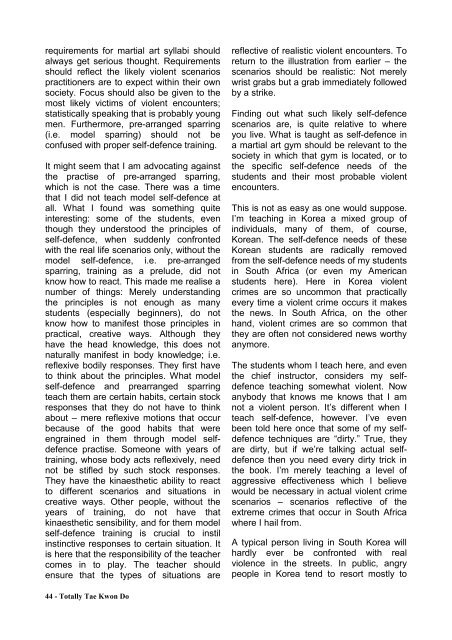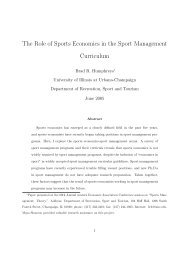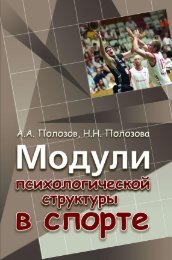Totally Tae Kwon Do Magazine - Issue 20 - Usadojo
Totally Tae Kwon Do Magazine - Issue 20 - Usadojo
Totally Tae Kwon Do Magazine - Issue 20 - Usadojo
Create successful ePaper yourself
Turn your PDF publications into a flip-book with our unique Google optimized e-Paper software.
equirements for martial art syllabi should<br />
always get serious thought. Requirements<br />
should reflect the likely violent scenarios<br />
practitioners are to expect within their own<br />
society. Focus should also be given to the<br />
most likely victims of violent encounters;<br />
statistically speaking that is probably young<br />
men. Furthermore, pre-arranged sparring<br />
(i.e. model sparring) should not be<br />
confused with proper self-defence training.<br />
It might seem that I am advocating against<br />
the practise of pre-arranged sparring,<br />
which is not the case. There was a time<br />
that I did not teach model self-defence at<br />
all. What I found was something quite<br />
interesting: some of the students, even<br />
though they understood the principles of<br />
self-defence, when suddenly confronted<br />
with the real life scenarios only, without the<br />
model self-defence, i.e. pre-arranged<br />
sparring, training as a prelude, did not<br />
know how to react. This made me realise a<br />
number of things: Merely understanding<br />
the principles is not enough as many<br />
students (especially beginners), do not<br />
know how to manifest those principles in<br />
practical, creative ways. Although they<br />
have the head knowledge, this does not<br />
naturally manifest in body knowledge; i.e.<br />
reflexive bodily responses. They first have<br />
to think about the principles. What model<br />
self-defence and prearranged sparring<br />
teach them are certain habits, certain stock<br />
responses that they do not have to think<br />
about – mere reflexive motions that occur<br />
because of the good habits that were<br />
engrained in them through model selfdefence<br />
practise. Someone with years of<br />
training, whose body acts reflexively, need<br />
not be stifled by such stock responses.<br />
They have the kinaesthetic ability to react<br />
to different scenarios and situations in<br />
creative ways. Other people, without the<br />
years of training, do not have that<br />
kinaesthetic sensibility, and for them model<br />
self-defence training is crucial to instil<br />
instinctive responses to certain situation. It<br />
is here that the responsibility of the teacher<br />
comes in to play. The teacher should<br />
ensure that the types of situations are<br />
44 - <strong>Totally</strong> <strong>Tae</strong> <strong>Kwon</strong> <strong>Do</strong><br />
reflective of realistic violent encounters. To<br />
return to the illustration from earlier – the<br />
scenarios should be realistic: Not merely<br />
wrist grabs but a grab immediately followed<br />
by a strike.<br />
Finding out what such likely self-defence<br />
scenarios are, is quite relative to where<br />
you live. What is taught as self-defence in<br />
a martial art gym should be relevant to the<br />
society in which that gym is located, or to<br />
the specific self-defence needs of the<br />
students and their most probable violent<br />
encounters.<br />
This is not as easy as one would suppose.<br />
I’m teaching in Korea a mixed group of<br />
individuals, many of them, of course,<br />
Korean. The self-defence needs of these<br />
Korean students are radically removed<br />
from the self-defence needs of my students<br />
in South Africa (or even my American<br />
students here). Here in Korea violent<br />
crimes are so uncommon that practically<br />
every time a violent crime occurs it makes<br />
the news. In South Africa, on the other<br />
hand, violent crimes are so common that<br />
they are often not considered news worthy<br />
anymore.<br />
The students whom I teach here, and even<br />
the chief instructor, considers my selfdefence<br />
teaching somewhat violent. Now<br />
anybody that knows me knows that I am<br />
not a violent person. It’s different when I<br />
teach self-defence, however. I’ve even<br />
been told here once that some of my selfdefence<br />
techniques are “dirty.” True, they<br />
are dirty, but if we’re talking actual selfdefence<br />
then you need every dirty trick in<br />
the book. I’m merely teaching a level of<br />
aggressive effectiveness which I believe<br />
would be necessary in actual violent crime<br />
scenarios – scenarios reflective of the<br />
extreme crimes that occur in South Africa<br />
where I hail from.<br />
A typical person living in South Korea will<br />
hardly ever be confronted with real<br />
violence in the streets. In public, angry<br />
people in Korea tend to resort mostly to

















